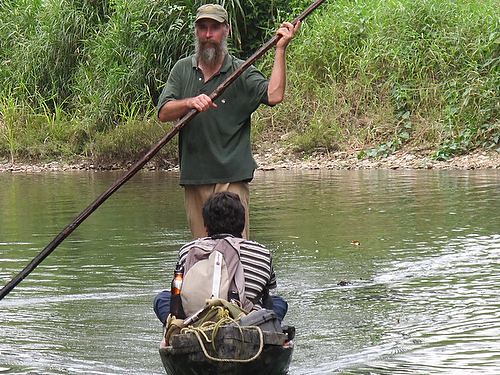It may not look like it at first, but Christopher Nesbitt has a big crew working for him here at Maya Mountain Research Farm.
There are the chickens, who recycle kitchen scraps into eggs and meat. There are the soldier flies, who recycle what the chickens don’t want into larvae for chicken food. There are the leaf-cutter ants, who aerate the compacted soil and serve as more chicken feed. And then there are the vast armies of microbes working to bring back the natural balance to what was once a stripped and sterile cattle farm.

“Every component on this farm gives us one of two things: a good, or a service,” says Nesbitt. “Sometimes they give us both.”
Our tour of Maya Mountain Research Farm was a lesson in natural cycles, from the compost barrel to the chicken coop, from the piggery to the agroforestry plot, from the aquaponics system to the composting toilet. The farm has become a research, demonstration and training center for sustainable agriculture, and Nesbitt has worked with local and international agencies to implement both permaculture and solar technology solutions to regional problems.
Nesbitt, a native New Yorker, came to Belize at the age of 19 and loved it so much he decided to stake a claim.
“I went from one jungle to another,” he jokes.
He bought the farm three years later and set about bringing it back to a natural state. The labor it must have taken to build two houses, two dorms and a number of outbuildings is staggering, especially considering that everything that didn’t grow here had to be poled in on a canoe-sized dory. Nesbitt has gotten so good at it that he can find his way two miles down the river to the next town in the dark of night – and frequently does so.
Nesbitt went a considerably different route than the rest of his family. One brother is a decorated Navy veteran; the other is a dot-com millionaire. For his part, he’s found his happiness up here on Maya Mountain with the simple things in life – like chickens, pigs and solar panels.
“Pigs have a natural inclination to tear things up,” Nesbitt explains. “So we take that behavior, which could be seen as destructive, and turn it into a constructive activity.” The pigs, which he’s preparing to add to the farm in the next year, will be cycled through paddocks that are planted with native root crops like coco yam, or tarot, and yuca, or cassava, to provide them with food as they root around and convert garbage into meat and fertilizer. When they move on to the next paddock, this space is a richly fertilized and plowed field, ready for planting beans, corn, sesame or whatever else he might want.
The barn is designed with concrete channels that are engineered to carry the waste to a central point, where the gases will be channeled into a biogas digesting system to provide fuel, which will be piped to the kitchen.
Nesbitt isn’t a big meat eater, but the animals will provide important services as well as generating revenue for the farm.
He’s also planning to add sheep, for milk and for meat. “Animals are a fantastic element to any system, because they can utilize things that we can’t,” Nesbitt says. “We could chew grass all day long, but I’d rather have them do it, and drink the milk.”
Animals also help with the timing factor. “When we have breadnut, everyone has breadnut, so we can’t sell them,” he says. “So we cycle the breadnut through the pigs and we get the pork and methane gas, then we return the slurry to the soil in fertilizer.”
Tropical soils tend to be very poor, he explained, and nutrient cycling is even more essential here than in some places. Agricultural and forestry practices over the past several centuries have badly degraded and eroded the soil, and traditional farming has produced fewer and fewer yields.
Agroforestry is the logical answer to this problem, Nesbitt believes, and he leads us on to one of his favorite slopes and has us take a seat.
“What you’re looking at is the equivalent of a biological flywheel,” he said, gesturing out toward a lush, multi-layered forest. “It’s an area that has finally ‘snapped’– it’s reached a point where it requires little or no maintenance. We get star apple, bukut (a leguminous pod-producing tree), peach palm, avocado, bananas, hog plum, coffee, cacao, sugar cane, breadnut, pineapple, turmeric, ginger, chi’kai (a vegetable that tastes like the cross between asparagus and artichokes)…. We get a lot of calories out of it, and we don’t put a lot of calories into it.”
One of the special features of Maya Mountain Research Farm is that it’s located amid the Lubaantun Mayan ruins, dating to 750 AD. Nesbitt holds the view that ancient Maya cultures built their civilization on agroforestry, simply because it’s much less work than the trinity of corn, bean and squash. He says corn was an important source of food, particularly for elite classes, but that the amount of energy invested to energy returned wouldn’t be enough to support such a society. He cites one scientific article that postulated that the primary food of the ancient Maya was the ramon nut, also called Maya breadnut.
“My neighbors have trucks and tractors, steel machetes, Roundup, 2-4 D and hybrid seed, yet none of my neighbors manage to make much surplus. They manage to get by, for life. There’s no way the Maya, who had none of these comparative values built a complex society on beans and corn.”
To schedule a visit at the Maya Mountain Research Farm, contact Christopher at [email protected]. Volunteers and interns are welcome, but it can also be a nice place for a retreat.
Created with Admarket’s flickrSLiDR.
